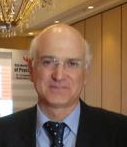
Nikos Makris
Bio
Dr. Nikos Makris is a systems neuroanatomist and imager. He is a Professor in the Departments of Psychiatry and Neurology at Massachusetts General Hospital and Harvard Medical School and the Director of the Center for Morphometric Analysis (CMA) at Massachusetts General Hospital (MGH). He is an internationally recognized expert in the morphometric analysis of the human brain as well as in brain anatomical connectivity using neuroimaging. His expertise extends into methods development and also in the neuroanatomical organization of the brain, and neural network analysis as it relates to behavior in normality and neuropsychiatric disorders. He has published over 250 scientific articles in this respect. Dr. Makris’ research track record involves the study of numerous neuropsychiatric disorders and neural networks using neuroimaging methodologies. He has published over 250 scientific articles in this respect. Dr. Makris’ work is reflected in a recently published report by the Thompson Reuters agency regarding the 2014 list of The World’s Most Influential Scientific Minds. The list includes 3,200 individuals around the globe who published the top 1% of highly cited papers in one of 21 broad fields during the decade of 2002-2012 and he is listed among 128 neuroscientists in the field of Neuroscience & Behavior worldwide. His research track record involves the study of numerous neuropsychiatric disorders and neural networks using neuroimaging methodologies.
Abstract
Multi-modal neuroimaging for understanding brain structure and function
This talk will be on multi-modal neuroimaging for understanding brain structure and function. Imaging technologies are shaping clinical research and practice given their non-invasive nature. The human body is very complex, structurally and functionally and the brain is arguably the most hidden part of the body. That our understating of the human brain has advanced more in the last three decades than in the rest of human history is a well-known fact and this seems to be a consequence of key technological discoveries as has occurred in other fields of science in the course of history. Neuroimaging enabled us to unconceal the brain thanks to computer technology. It is not surprising that MRI was rated by general practitioners in the USA as the principal contributor to medical practice. A major effort of current neuroscience is to map the neural systems that underlie human brain function. This ambitious effort relies principally on two modalities of MRI, namely structural and functional neuroimaging. These advances are expected to advance our understanding of human brain structure and function as well as of human behavior. Importantly, they will improve clinical practice especially in implementing such neuropsychiatric and neurosurgical procedures and treatments as deep brain stimulation (DBS) and transcranial magnetic stimulation (TMS). In this presentation there will be discussed the impact of multimodal neuroimaging technology in basic neuroscience of brain circuits and also in clinical neuroscience with specific example applications of DBS and TMS in enabling the practice of precision neuropsychiatry and neurosurgery.